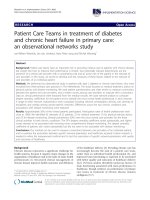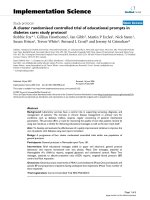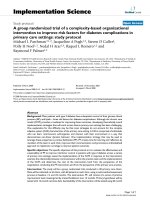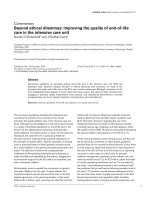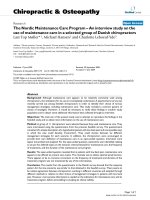Models of Diabetes Care in PHC
Bạn đang xem bản rút gọn của tài liệu. Xem và tải ngay bản đầy đủ của tài liệu tại đây (485.61 KB, 35 trang )
Models of Diabetes
Care in PHC
Dr Nabil Sulaiman
The University of Sharjah
The University Melbourne
Brought to you by
This Presentation
Trends
in diabetes
Lifestyle interventions- evidence
Models of interventions in PHC:
Diabetes Nurse Educator
(DNE)
COACH model
Chronic Disease Self
Brought to you by
management
Diabetes in UAE
High prevalence in the Gulf
Countries. In the UAE the prevalence
is:
24% of adults
40% with diabetes and IGT
Diabetes is occurring in younger age
Brought to you by
Environmental and
behavioral changes
New dietary habits (what and how we
eat),
Lack of physical activity,
Overweight/ obesity, and
Stresses of urbanization and working
condition
will lead to further rise of CVD and
diabetes, and their risk factors. Brought to you by
Evidence
RCT in Finland and the USA have
demonstrated that the incidence of
diabetes can be reduced by about
57% by modifying:
• Physical activity and
• Diet
(Tuomilehto et al 2001, Knowler et al 2002)
Brought to you by
Lifestyle Changes
However, uptake of such lifestyle
changes has been poor
Programs developed to enhance the
uptake, such as:
Diabetes Nurse Educator
Coach program
Chronic Disease Self- management
Others
Brought to you by
In Primary Health Care
In Australia, people with T2D have 80%
of their care in General Practice
Diabetes requires the GP to practise
biomedical, anticipatory and
psychosocial care using evidencebased and patient-centred medicine and
Patient to engage actively in managing
their illness.
Brought to you by
Diabetes Nurse Educator
Trained nurse
Engage, educate and empower patient to
manage diabetes and impact of disease on
patient and family
Based on trust and partnership between
PHC centre- Diabetes nurse educator and
patient
Patient determines agreed targets
Continuity and access
Brought to you by
Diabetes Coach Program
Tested in Melbourne using RCTs for CVD
Trained nurse or dietitian to do COACH
Following diagnosis or after discharge
from hospital
Education and empowerment
Patient determines agreed targets
Follow up consultation or phone calls
Showed benefit in several outcomes
Brought to you by
Chronic disease self
management
Is an effective way in which patients are
empowered to become more active and
effective in managing their disease.
Patient engages in “activities that protect
and promote health, monitoring and
managing of symptoms and signs of
illness, managing the impacts of illness
on functioning, emotions and
interpersonal relationships and adhering
to treatment regimes”
Brought to you by
Brought to you by
Chronic Disease Self
Management
(CDSM) Stanford University
Kate Lorig
Director of the
Stanford Patient
Education Research
Center
Brought to you by
Stanford CDSM Program
Is a workshop where people with different
chronic diseases attend
Teaches the skills needed in the day-to-day
management of treatment and to maintain and/or
increase life’s activities.
The Program has been adopted by NHS, the
Diabetes Society of British Columbia in Canada,
Kaiser Permanente, etc
It has been translated into Chinese, Vietnamese,
Norwegian, and Italian. The patient book is
available in Japanese
Brought to you by
Stanford Program
Small-group workshops,
Generally 6 weeks long,
Meeting once a week for about 2 hours,
Led by a pair of lay leaders with health
problems of their own,
The meetings are highly interactive,
focusing on building skills, sharing
experiences and support.
Brought to you by
One Step Ahead
Seminars for people with pre diabetes
Evidence of reduction of 0.5% HbA1C
Brought to you by
Patient empowerment
through CDSM
Patient empowerment has a crucial role in the treatment
of chronic disease:
knowledge and skill development to understand and
manage one’s condition and the confidence to use that
training for better self care and greater compliance
Feeling of control and skill development to achieve a
more interactive relationship with health care
professionals, with the capacity to demand good quality
care
The patient becomes a better self advocate/agent, more
able to get from the health system what they need in
particular.
Brought to you by
Uptake of lifestyle
However, uptake of such lifestyle changes has
been poor
Programs developed to enhance the uptake,
such as:
Diabetes Nurse Educator
Coach program
Chronic Disease Self- management
Others
Brought to you by
Projected prevalence of diabetes in 2025
Number of people
< 5,000
5,000–74,000
75,000–349,000
350,000–1,500,000
> 1,500,000
No data available
Total cases = 300 million adults
Adapted from World Health Organization. The World Health Report: life in the 21st century, a
vision for all. Geneva: WHO, 1998.
Brought to you by
The increasing global
prevalence of diabetes
Patients (millions)
250
200
150
Type 1
Type 2
100
50
1994
Estimates from
McCarty and Zimmet, 1994
2000
Year
2010
Brought to you by
Type 2 diabetes prevalence (millions)
Projected growth of Type 2
diabetes by region
120
1997
120
100
100
80
80
60
60
40
40
20
20
0
0
a a
a
a
ic sia eric ric ope ni
r
Af A m me ur cea
A A
E O
h in
t
r
t
N o La
mos et al. 1997
2010
a a
a
a
ic sia eric ric ope ni
r
Af A m me ur cea
A A
E O
h in
t
r
t
N o La
Brought to you by
Lifestyle modification
•
•
•
•
Diet
Exercise
Weight loss
Smoking
cessation
If a 1% reduction in HbA1c
is achieved, you could
expect a reduction in risk
of:
•
•
•
21% for any diabetesrelated endpoint
37% for microvascular
complications
14% for myocardial
infarction
However, compliance is poor and most patients will require
oral pharmacotherapy within a few years of diagnosis
Brought to you by
Stratton IM et al. BMJ 2000; 321: 405–412.
Type 2 diabetes in
different populations
Lowest rates
Highest rates
(Rural India)
Asian Indian
(Fijian Indian)
(Rural Kiribati)
Micronesian
(Urban Kiribati)
(Rural Tunisia)
Arab
(Oman & UAE)
(Central Mexico)
Hispanic
(US Mexican)
(Rural China)
Chinese
(Mauritian Chinese)
(Rural W. Samoa)
(Urban W. Samoa)
Polynesian
(Rural Tanzania)
African
(US Afr. Amer.)
(Poland)
European
(Laurino, Italy)
(Rural Fiji)
Melanesian
(Urban Fiji)
0
5
10
15
20
Prevalence of Type 2 diabetes (%)
Amos et al. 1997
25
Brought to you by
Diabetes Australia Facts 2008
T2DM in CALD populations:
1.
2.
3.
4.
5.
Prevalence of diabetes
Prevalence of risk factors
Complications
Hospitalisations due to nontreatable diabetes
Death rates due to diabetes
Brought to you by
Diabetes Australia Facts 2008
1.
2.
3.
4.
Prevalence of diabetes is increasing
over time
Reduces quality of life
Preventable via lifestyle modifications
Some population groups are at higher
risk including CALD
Brought to you by
Meta-analysis of 11 trials in CALD
1.
2.
3.
4.
5.
Improved HbA1c after culturally at 3M
Weight Mean Difference -0.3% at 3M and
0.6% at 6M
Knowledge scores improved at 3M
Healthy life style improvement at
No difference in secondary outcomes:
lipid levels, qoL, self-efficacy, BP,
Hawthorne K, Robles Y, Cannings-John R, Edwards S. Culturally appropriate health
education for type 2 diabetes in ethnic minority groups. Cochrane Database of
Systematic Revies 2008 (3)
Brought to you by


